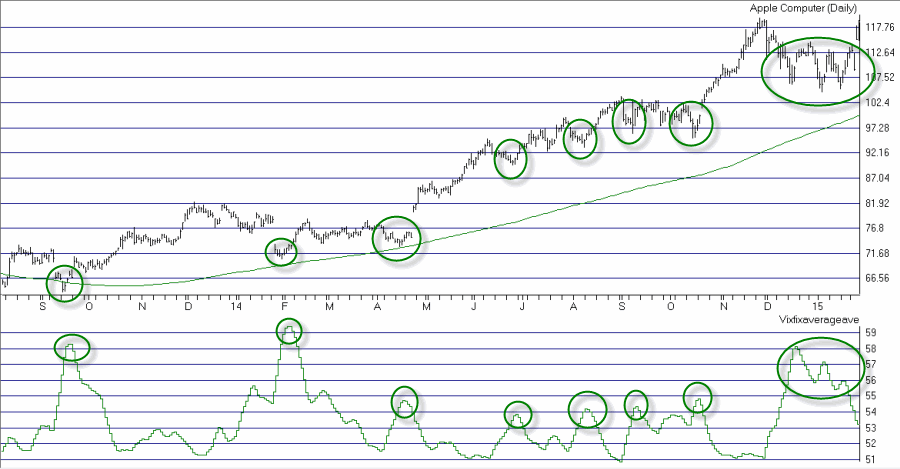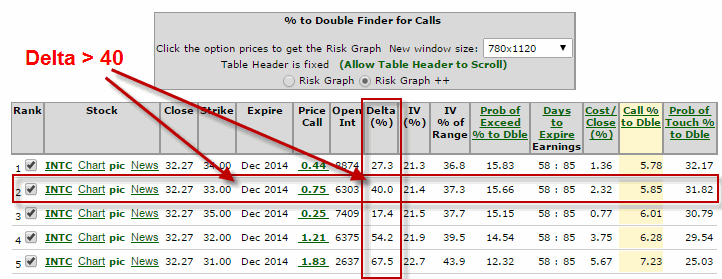The VIX index is calculated by the CBOE using option data on SPX options (See Figure 1). In a nutshell it measures the current implied volatility of a subset of the options traded on SPX. If you have not the slightest idea what any of that means, fear not, for basic interpretation is fairly straightforward:
*VIX rising sharply and/or high: Traders are – or are becoming – fearful.
*VIX declining and/or low: Traders are – or are becoming – complacent.
In the cesspool of human frailties that is the financial markets (at least it’s what makes them move), “fear is good” and “complacency is bad.” At least generally speaking.  Figure 1 – SPX vs. VIX Index (courtesy AIQ TradingExpert)
Figure 1 – SPX vs. VIX Index (courtesy AIQ TradingExpert)
A close look at Figure 1 reveals the concept – when the market sells off, VIX “spikes” as fearful traders bid up put option prices on SPX which in turn increases the implied volatility of said options (if you want to know the inner workings please consult with my friends at Google).
In any event, one problem is that the VIX Index is designed to track investor sentiment across the broader stock market. But is there a way to apply the VIX concept to individual stocks and ETF?
Would I ask the question if I though the answer was “No?”
The William’s VixFix Method
A number of years ago, the author of some of my favorite trading books, Larry Williams, disclosed a simple method that he had devised for emulating the VIX index for individual securities without involving complicated computer formulas or option data. And when I say “simple method” I mean “simple method.”
Highest Close=Highest closing price in most recent 22 trading day
Williams VixFix=(((Highest Close – Today’s Low)/ Highest Close)*100) + 50
Figure 2 displays SPX in the top clip with the William’s VixFix indicator plotted just below it. The bottom clip displays the actual VIX Index. The key thing to note is that even though the VixFix indicator relies only on price data, it looks and acts a lot like the VIX Index itself. So in a nutshell you have a “VIX like” indicator that can be applied to any security – with the basic premise being that “spikes” in the VixFix indicator highlight “fear” on the part of traders regarding the security in question, which may in turn highlight a buying opportunity. Figure 2 – SPX with VixFix (top) vs. Vix Index (bottom) (courtesy AIQ TradingExpert)
Figure 2 – SPX with VixFix (top) vs. Vix Index (bottom) (courtesy AIQ TradingExpert)
Going Two Steps Forward
For better or worse, I have never been one to “leave well enough alone” (Sorry, it’s just my nature). So I eventually “double smoothed” the original VixFix indicator to get something a little less, um, “jumpy”.
What I came up with I call the “VixAverageAve” and is calculated as follows:
Highest Close=Highest closing price in most recent 22 trading day
Williams VixFix=(((Highest Close – Today’s Low)/ Highest Close)*100) + 50
VixFixAverage= 3-day exponential average of William’s VixFix
Jay’s VixFixAverageAve = 7-day exponential average of VixFixAverage
The code for AIQTradingExpert EDS is as follows:
!VixFixAverageAve code
!Written by Jay Kaeppel; based on VixFix indicator created by Larry Williams
hivalclose is hival([close],22).
vixfix is (((hivalclose-[low])/hivalclose)*100)+50.
vixfixaverage is Expavg(vixfix,3).
vixfixaverageave is Expavg(vixfixaverage,7).
So what the heck does all of this do for us? Well, there are many ways to interpret and implement the results. In the broadest stroke possible let me just highlight two possibilities:
For a security trading above its 200-day moving average (i.e., in an established uptrend, traders can look for:
- a) a VixFixAverageAve “spike” and reversal, and or,
- b) a rise by the VixFixAverageAve for 6 to 8 consecutive trading days followed by a reversal
Please note that it is my opinion that waiting for the actual reversal in the indicator is essential. These events often (but not always, ah, there’s the rub) highlight decent short-term trading opportunities. Figure 3 displays ticker AAPL with some potential signals highlighted. Figure 3 – Ticker AAPL with Jay’s VixFixAverageAve (courtesy AIQ TradingExpert)
Figure 3 – Ticker AAPL with Jay’s VixFixAverageAve (courtesy AIQ TradingExpert)
Another possibility is to consider any spike and reversal above 60 to be a potential (very) short-term buying opportunity, even if the security is below the 200-day moving average. One word of subjective caution is to be careful if a stock or ETF appears to be in a “waterfall” decline. Possibly the “best of all worlds” is a spike and reversal above 60 while price is above the 200-day moving average. Figure 4 displays two such signals for ticker INTC. Figure 4 – Ticker INTC with price above 200-day moving average and VixFixAverageAve reverses after topping 60 (courtesy AIQ TradingExpert)
Figure 4 – Ticker INTC with price above 200-day moving average and VixFixAverageAve reverses after topping 60 (courtesy AIQ TradingExpert)
Using VixFixAverageAve with Options
One primary danger associated with any “buy the dip” indicator is the potential for attempting to “catch a falling safe.” It’s a great trick when it works, but it can get a little, er, messy, when it doesn’t. So one great way to trade indicators like VixFixAverageAve is via the use of options. Let’s take a look at one example.
As shown in Figure 4, on 10/22/14 the VixFixAverageAve reversed down after rising above 60 for ticker INTC. In Figure 5 you see the input screen for the “Percent to Double” routine built into www.OptionsAnalysis.com software. Figure 5 – Percent to Double Inputs (courtesy www.OptionsAnalysis.com)
Figure 5 – Percent to Double Inputs (courtesy www.OptionsAnalysis.com)
In Figure 6 you see the output. The top recommended trade was to buy the December 34 call. However, my own personal preference is to buy calls with a Delta of roughly 40 or more. So I will look at the second trade listed – buying the December 33 call.
Figure 6 – Percent to Double Output (courtesy www.OptionsAnalysis.com)
Figure 7 displays the risk curves for buying a 1-lot. 
Figure 7 – Risk Curves for INTC December 33 call (courtesy www.OptionsAnalysis.com)
The advantage of this approach is that the maximum risk on a 1-lot is $75 even if the stock were to unexpectedly plummet. Above the breakeven price of $33.75 this trade enjoys unlimited profit potential.
When to take a profit and/or adjust a winning trade is an entirely separate topic, but for the record, by 11/28 this position would show a profit of +460% following a 15% rally by INTC stock as shown in Figure 8.
Figure 8 – INTC December 33 call gain +460% as INTC stock rallies +15% (courtesy www.OptionsAnalysis.com)
Summary
So is VixFixAverageAve the “World Beater Indicator?” Not at all. To expect any indicator to magically churn out great signal after great signal leading to riches beyond the Dreams of Avarice is simply not realistic. So simply note the purpose of an indicator like this. The real purpose of this indicator is to highlight points in time when investor “fear” regarding a given security may have gotten overdone and is about to reverse soon. By combining that “possibility” with a low dollar risk option trade is probably not the worst idea I’ve ever come up with.
Come to think of it, I can state definitively that this is not the worst idea I’ve ever come up with. Trust me on this one.
Jay Kaeppel



Hi Jay. Do you see this indicator to be significantly better than using RSI for example? I’ve just programmed it into ProRealTime. A combination of RSI[14]60 and Close>MA[200] seems like a winning combo. Will have to test…
Thanks for the awesome blog. As you can see, I’ve been paying close attention.
Matt, just curious, I don’t know what the designation RSI[14]60 mean? Thanks, Jay
Woops, typo! I meant a 14-period RSI value that was <30. Fumble fingers meant to type "RSI[14]<30"
What is the significant of adding +50 at the end
since I do not see it in the Active Traders Magazine Dec 2007
Williams VixFix=(((Highest Close – Today’s Low)/ Highest Close)*100) + 50
Good question. I don’t actually remember. If you leave off the +50 you would just be looking at values that are 50 points lower.